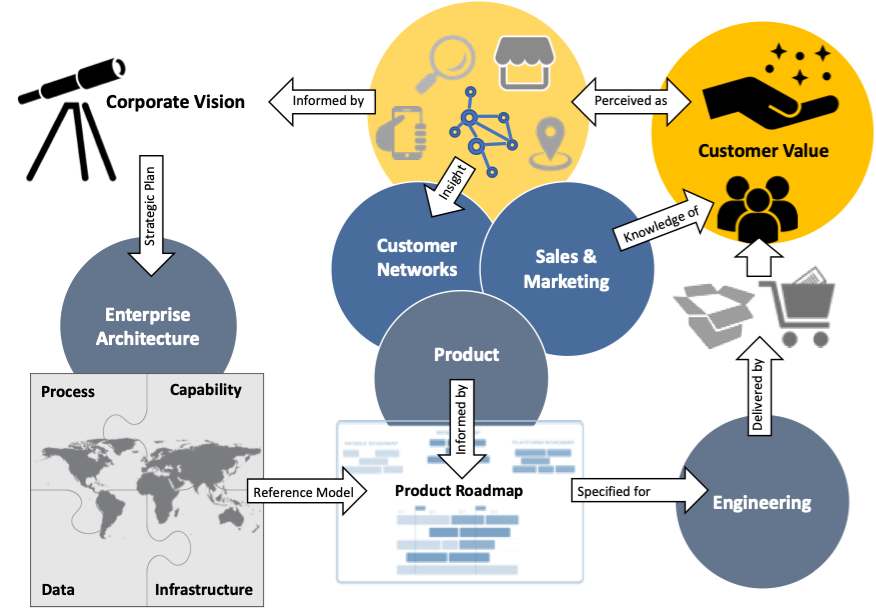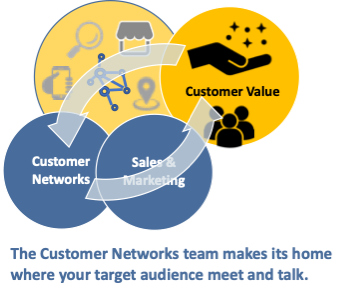The very essence of the organisation must be to focus on continually delivering value to the customer, be that B2C, B2B2C or B2B.

We exist to deliver customer value. Engineering must work to a direction informed by the Product Roadmap, which itself is the result of insight into the customers’ perception of the value it receives.
Further, the Product Roadmap must be aligned to the Enterprise Architecture of the company, which itself is updated from time to time in response to changing corporate vision as Execs judge how their products are fairing in the market.
Customer Networks
We’ve built our products – now how do we sell them?
Customers no longer line up meekly at our shop door, impatient to buy what we have to offer. Instead they share their experiences on social media and, for all our attempts to explain our Why and send out targeted messages explaining the value we offer, we can only influence, never control.
People's embeddedness in social networks affects their behaviour as consumers. Interactions within consumer networks can affect demand and market outcomes in ways not considered in the neoclassical theory of consumer choice.
One of the most powerful business tools for attracting customers and increasing revenue is a strong network.
That’s why we need to create an organisational Customer Networks capability, to interact with and influence our target audience. A team who are constantly alert to discussions about your brand or products on third-party sites or social networks, who use the whole breadth of inbound marketing techniques to interact with the target audience and who build connections between those people and your brand.

Five core behaviours of networked customers
By understanding and leveraging the five core behaviours of networked customers, businesses can pursue strategies that will create value and produce the products, services, and business models that will thrive in a networked future. Each strategy helps attract, engage and delight, and gives a potential customer another reason to buy from you.
-
The Access strategy: Be faster, be easier, be everywhere, be always on. Customers seek to access digital data, content, and interactions as quickly, easily, and flexibly as possible. Whether from our smart-phones, search engines, or networked TVs, we want it all and we want it now. By offering mobile, location-aware, and on-demand experiences, businesses can create real value for customers.
-
The Engage strategy: Become a source of valued content. In an environment of abundant media and rampant ad-skipping, businesses that want to earn customer attention need to create content that customers will actually want to consume. Today, every business needs to think like a media business. Whether aiming for a broad audience or a narrow niche, businesses can earn new customers by producing or curating content that entertains, informs, or answers a specific need.
-
The Customize strategy: Make your offering adaptable to your customers' needs. Networked customers are not looking for cookie-cutter experiences, identical content, and mass-produced products, especially in the digital realm. By giving them tools to customize products, services, and content to suit their interests, businesses can add real value that will differentiate them from competitors and engage customers more deeply.
-
The Connect strategy: Become a part of your customers' conversations. Customers today are constantly sharing ideas and opinions in social media conversations, offering rich insights and shaping brand perceptions. Companies can benefit by joining these conversations - either in popular forums like Facebook and Twitter or by creating their own forums where customers express themselves, vote, and share ideas.
-
The Collaborate strategy: Invite your customers to help build your enterprise. Customers seek to collaborate on collective projects and goals through open platforms. Beyond just sharing in conversations, networked customers are working together to design clothing, write computer software, and elect political candidates. By creating platforms that invite and motivate customer collaboration, organisations can unleash tremendous innovation and creativity.
Next:
We look at each of the Three Laws in more detail in separate posts:



